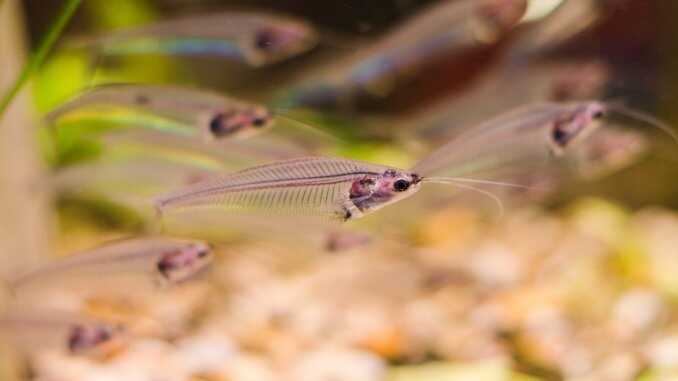
If you’re looking for a fish to add an element of surprise to your tank, look no further than the Glass Catfish. After one look at these transparent fish, it is clear why they have become so popular in the aquarium hobby.
Their clear bodies have been catching the attention of aquarists of all levels since they were introduced.
Originally, these fish are from South East Asia, they are at home in vegetated tanks full of peaceful fish like tetras. This setting reflects their natural habitat and creates a calm environment that mirrors their calm nature.
If you are thinking about adding these unique fish to your aquarium, this complete guide will take you through how to care for them, ideal tank mates, tank requirements, breeding, and much more.
TABLE OF CONTENTS
Glass Catfish Facts & Overview
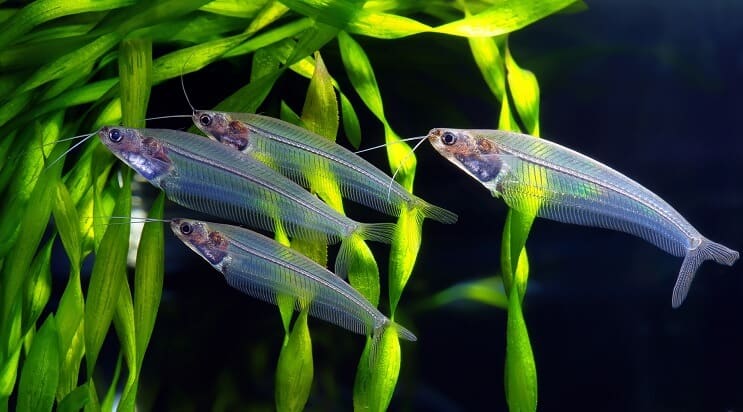
| Category | Rating |
| Care Level: | Moderate |
| Temperament: | Calm |
| Color Form: | Transparent |
| Lifespan: | 7-8 years |
| Size: | 5 inches |
| Diet: | Omnivore |
| Family: | Siluridae |
| Minimum Tank Size: | 30 gallons |
| Tank Set-Up: | Planted community |
| Compatibility: | Community tanks |
The Glass Catfish has many names including Ghost Catfish or Phantom Catfish. All of these are common names that apply to several different species of skeleton catfish.
Initially, the most popular species of this family was known as the Kryptopterus bicirrhis. However, it was concluded that this was a misidentification and as such the popular species for aquariums are now known as Kryptopterus vitreolus.
The older title of Kryptopterus bicirrhis is reserved for the larger and more aggressive Glass Catfish. Fortunately, these are now very rare in the aquarium hobby/trade.
This guide will focus on the most popular species of Glass Catfish which is suitable for beginners; Kryptopterus vitreolus.
Glass Catfish got their name from their transparent body that lets you see their bones and organs. The scientific name comes from the Greek word kryptos, meaning hidden and pterýgio (fin). The name ‘hidden fin’ refers to the hardly visible tail fin.
When people hear the word catfish they tend to think larger freshwater fish that spend the majority of their time sucked onto rocks or feeding on the bottom. These fish defy that image to a certain point; yes, they do have the barbels that most catfish do, but they have chosen to leave the rocks in exchange for a free-swimming lifestyle.
These fish will school together. They are peaceful by nature and extremely timid, especially when they are first introduced into your tank.
After a few weeks however they will rise to the middle of the tank and swim actively, this brings amazing energy to the tank.
Plants are key for these fish as they will use them as hiding spots which help to block bright, direct light that they tend to avoid.
In terms of a Glass Catfish’s lifespan, you should expect a healthy one to live up to 8 years.
Typical Behavior
These fish will school together which makes for an incredible show; it is as if you have 5 or 6 skeletons swimming around in your tank!
Most catfish, while energetic, will stay on the bottom of the tank, whereas Glass Catfish are exceptions and enjoy swimming around.
They make great additions to peaceful community tanks and tend to keep to themselves, only ducking for cover when disturbed.
Appearance
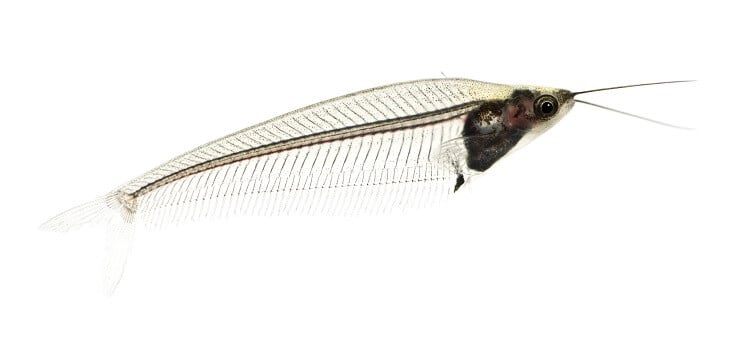
The first thing you will notice about these fish is their clear appearance. Their transparent skin lets you see their bones and organs.
All along the body, you can see their ribs vertically and a central spinal column. They do have a slightly raised portion of their back which is where their dorsal fin is. Their tail fin is nearly invisible, as is the ventral fin on their stomach. These two fins together allow for them to swim up and down in the water column.
Not only does this look amazing, but it also provides quite a bit of camouflage from predators. Their clear color means they are hard to see (which makes them harder to eat); similarly to the ghost shrimp.
Another big part of their appearance is the barbels on their head. This is something most catfish share to some extent.
They extend past their face, out from their nose. These are what give catfish their name as it looks like they have whiskers. They make them extremely sensitive to changes in their surroundings and some can even detect electromagnetic wave.
Scientists are fascinated by this and are attempting to understand how this can help patients with Epilepsy and Parkinson’s.
They only grow to about 5 inches and have a long, slender body.
Habitat and Tank Conditions
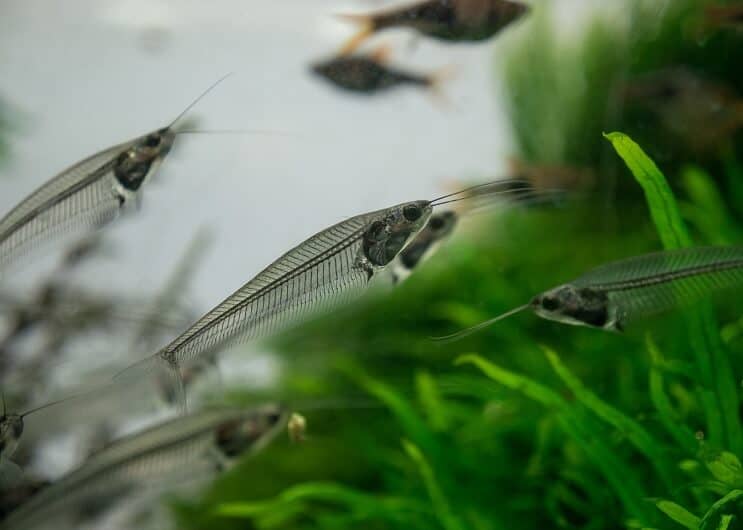
Glass Catfish are originally from Thailand where they inhabit moderate moving rivers and streams. They mostly stay in the middle of the water column and rarely stray too far from the safety of the river bed.
Their barbels are used heavily as the water visibility tends to be low. Without these sensory organs, it would be much harder for these fish to survive in this environment.
Another adaptation for survival is the clear nature of the skin. When water conditions are poor, and visibility is low, having clear skin makes it nearly impossible to distinguish these fish from debris.
When being kept in an aquarium it is important to make sure they feel just as at home as they would in a river or stream.
Ideal Tank Conditions
When talking about tank conditions, they are just as fragile to water parameters as their name suggests. They don’t respond well to fluctuations in temperature, pH, or other chemical changes.
These numbers are not guidelines, but more of a must. If they begin to change, these fish will begin to die.
Water Conditions:
- Temperature: 75-80°F
- Hardness: KH 8-12
- pH: 6.5-7.0
- Water flow: Moderate
Due to the strict water parameters these fish require, they are harder to take care of than other easier beginner species.
They will thrive best in a tank that is 30 gallons or more. This gives them plenty of room to swim in the middle regions of the tank as well as plenty of space to hide if spooked. Make sure the tank is well planted.
Plants will not only help clean the water, but they will give hiding spots to these fish and feed other organisms in your tank. Think about adding common plants like Java Fern, Java Moss, or Hornwort which are all incredibly hardy.
Larger grained or sharper substrates can cause some damage to their barbels, so use small gravel or sand.
What Size Aquarium Do They Need?
Glass Catfish need a minimum of a 30-gallon tank. They need enough space to school and swim together as they please. Because they are so shy, the bigger aquarium gives them the ability to feel safer in their home.
How Many Can Be Kept Per Gallon?
Due to their schooling nature, having around 6 in the 30-gallon tank is best. This means keeping 1 Glass Catfish for every 5 gallons.
You need to give them plenty of space because if not, health risks can arise.
Diseases and other growth defects can pop up if you overcrowd your tank. Sometimes having fewer fish can truly be better if all of them are happy in their community (more on this later).
Tank Mates
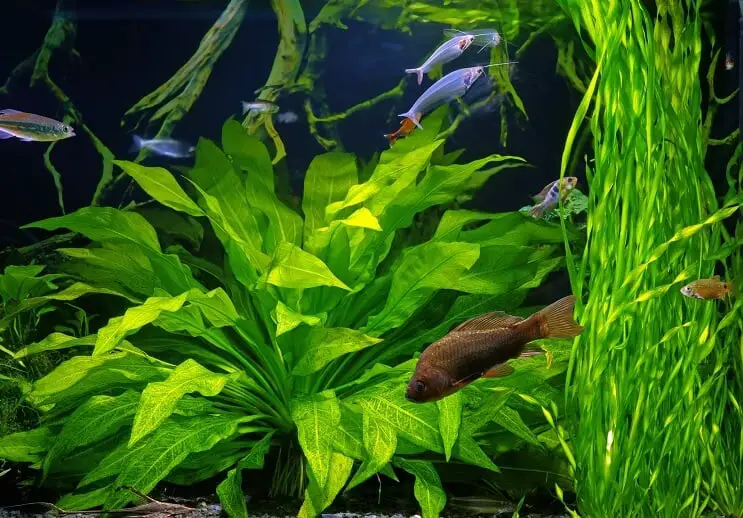
These fish work perfectly in community tanks. For those that do not know what that means, community tanks are full of different species of peaceful fish that live well together and do not attack one another.
Fish such as Swordtails, Mollies, and Celestial Pearl Danios are perfect tank makes for Glass Catfish. They are all peaceful and will not bother or out-compete your catfish.
Not only are these fish easy to keep, but they will live nicely with Glass Catfish. This means you can start with them first and then add more fish once you think you are ready.
Fish competing is another thing to keep an eye on. Aggressive fish may attack the calmer and slower fish. This can lead to the death of the slower fish as they struggle to find food.
They shouldn’t be kept with any large or aggressive fish. This is why Tiger Barbs and Sharks are not going to work in your tank. You should also avoid keeping fish like Cichlids and Oscars because they are very aggressive and will attack and eat your fish.
Keeping Glass Catfish Together
Keeping these fish together is very important. They will form tight social groups like they would in the wild, so mimicking that is important. Having only 1 Glass Catfish will lead to that fish likely dying due to being stressed.
Diet
In the wild these catfish mostly eat zooplankton and other small worms or invertebrates. Whilst they do live in the middle of the water column, they are still selective feeders. They have even been known to eat small fish (baby guppies) and mosquito larvae.
This can be replicated in an aquarium by using frozen or live food such as Grindal worms, Daphnia, Brine Shrimp, and Moina. But in your tank, they will eat a wide range of food that includes pellets or flakes.
Even consider making your own fish food to make sure they not only have the best diet, but you are feeding your fish nothing but the best ingredients.
Make sure to keep an eye on them as they eat to check that they are consuming the food that you are giving them. Also, make sure there are no fish that are bullying them and stopping them eating.
Feeding once or twice a day will keep these fish happy and healthy. Make sure to only feed them as much as they will eat in a couple of minutes. Overfeeding fish will lead to excess nutrients in your tank which can lead to large amounts of algae and bacteria.
Because of the shy nature of these fish, it is important to make sure that they are getting the food you feed them. Some fish of other species, even if peaceful, will be more active in getting food and can scare your Glass Catfish.
Once you find out which fish are more active when feeding, you can then feed your fish methodically to make sure all fish have food. Try feeding one side of the tank that has the fish which are more active before adding food on the other side.
This lets the more active fish eat first and then gives time to the slower, more shy fish.
Care
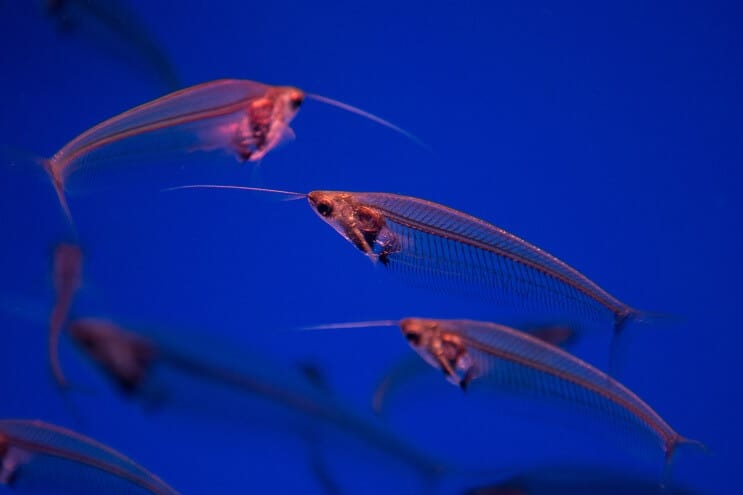
The biggest problem when caring for these fish is changes in the water conditions. The main reason these fish are not the easiest to keep is because of how hard it can be for people to maintain the strict water parameters.
To limit the risk of harm to your fish, make sure that you are adding them to an established tank that has already been cycled.
As for diseases, there is nothing special that they can be infected with. All you must look out for are the general sicknesses that aquariums can be impacted with such as:
- Ich: White grainy sand-like substance on their skin, will also be seen gasping at the surface of the water.
- Dropsy: Bloating and protruding scales.
- Fungus: Gray/white growth on the fins.
- Lice: Restless fish, will usually rub themselves on surfaces to try and remove lice.
As long as you keep your water parameters within the levels mentioned, carry out regular water changes, and don’t overfeed them, it’s unlikely they will be exposed to any of these illnesses.
Another important point is to always quarantine any fish before you add them to your community tank; this way you can thoroughly observe them and check they’re not ill.
Breeding
While these fish do breed in the wild it is currently unknown how exactly they breed in captivity. More research is being done but has been inconclusive so far.
There are a few reports of people being successful in breeding them in captivity.
In the wild, these fish spawn seasonally during times of heavy rain. In a tank setting, this means lowering the water temperature to around 73°F and adding small amounts of freshwater every day.
The lower temperature and freshwater will help to mimic the rainy season and make them believe that it is time to breed. It is also important to feed them high levels of live food. Wild fish have an abundance of food around this time which gives them the energy needed to spawn.
If you do have success in breeding these fish, then the female will spread the eggs on the aquarium plants. These eggs will then hatch after 3-4 days.
The newly hatched fry will be very small but large enough to eat baby brine shrimp.
Another challenge is determining which fish is male and female. Females are only slightly larger and have a slightly larger stomach for keeping eggs.
Is a Glass Catfish Suitable for your Aquarium?
No matter what, do not let the appeal of the Glass Catfish fool you into thinking that they are the easiest fish to care for. They are going to require more work than other beginner fish.
The conditions of the tank must be within their preferred range or things will begin to go wrong. This can be a huge challenge for new aquarists, meaning these fish are not going to be right for you.
However, if you’ve already made all your beginners mistakes, and are up to the challenge, or are a seasoned aquarist then they will make a great addition to your tank.
The visual appeal of these clear fish is their biggest selling point. There are few fish that give your tank such a unique look.
Do you already keep Glass Catfish, or are you thinking of getting a school for your tank? Let us know why you decided to choose these swimming skeletons in the comments section below.

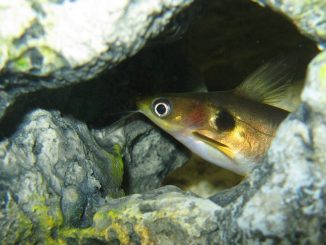
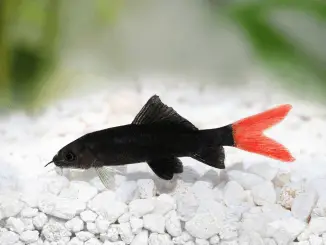


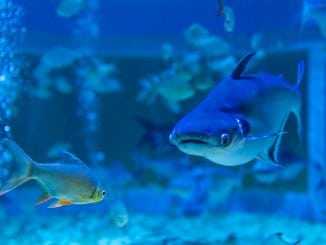
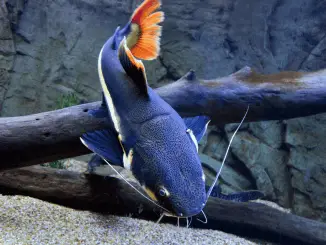
I keep ghosts in my tank. The ones I have, have been in my tank about 2 years. For me, they have been hardier than my other fish. None of my other fish bother them any. My beta, african feather fin catfish, and upside down catfish all leave the ghosts alone. Sometimes, they will school together. All my fish recognise me and get excited at feeding time and will swim up to my hand when I clean the tank. Love my fish.
I’ve kept the type you mentioned before about 6in total&3 African3striped version…my only hesitation now is due they feed off the bottom at all,if so they would be perfect with khuli loaches,dogo loach,&hilstream loach as part of the hilstream cleanup crew for my 3o gallon or I might be looking at something like the rainbow/retail shark!
I have four in a 120 gallon tank with other larger fish. They stick together like glue and rarely move from their preferred spot in the tank.
I bought 8 glasscats 2 years ago now, I have them in an aqua one ufo 700 with corys, marble hatchets, and ember tetras this is a heavily planted tank with lots of drift wood causing my water to be very tannin coloured however this has allowed the glasscats to breed and I now have 15 (though I did lose 1 of the adults) i seam to get breeding behaviour every 6 months upon live food feeding I don’t know if I’m just lucky but if this helps other’s breed enjoy
Hi Lee, thanks for sharing your experience with us. Robert
one of my glass catfish is showing a solid whitish just behind the dark ‘neck’ part.The others appear normal.I don’t know if this is bad and I should quarantine the one catfish.
My ghost catfish just had babies. Do you know how long it will take for them to grow? One of my angel fish keep sucking the babies up and then spitting them out like its trying to clean them
Are you sure they are gohst cat fry¬ Angle fish fry?(fresh water Agel fish is actually a species of chiclid&chiclids tend to only care for their own fry.
I LOVE Glass Catfish SO MUCH!!!!! Good job with this!!!!
I have a school of glass catfish in a 100 gallon tank. Along with lemon tetras, bristle nose cats, a feather fin cat and a large angelfish. All get along with the glass catfish.
Lower level lighting keeps them happy, brighter light at one end of the tank keeps the plants happy. Once the lights are dimmed at night they really come alive. They are lightning fast at this time and perfect time to feed them along with the feather fin cat who hides most of the day. Some will approach me at feeding time but during the day they stay in one area in a tight school. Not a good fish if you want to show off the tank’ occupants during the day, perfect for anyone observing during the evening.